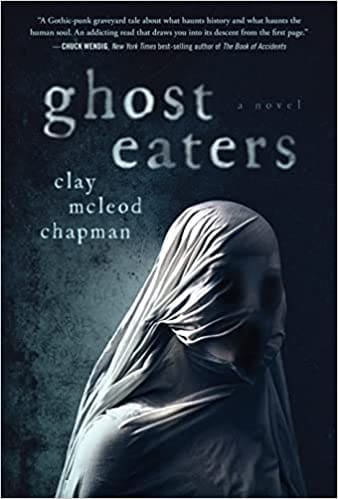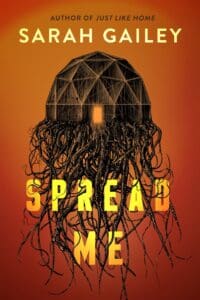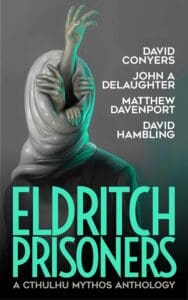
Synopsis:
Erin hasn’t been able to set a single boundary with her charismatic but reckless college ex-boyfriend, Silas. When he asks her to bail him out of rehab—again—she knows she needs to cut him off. But days after he gets out, Silas turns up dead of an overdose in their hometown of Richmond, Virginia, and Erin’s world falls apart.
Then a friend tells her about Ghost, a new drug that allows users to see the dead. Wanna get haunted? he asks. Grieving and desperate for closure with Silas, Erin agrees to a pill-popping “séance.” But the drug has unfathomable side effects—and once you take it, you can never go back.
Review:
“Ghost Eaters,” by Clay McLeod Chapman is a psychedelic autopsy of grief, addiction, and what it means to be haunted. Fungus fuelled, and full to the brim with all too relevant social commentary, as well as some bloody history lessons, “Ghost Eaters,” delivers on the reputation that precedes it. If you’re looking for a hallucinogenic “Pet Sematary,” or “Ling Hun,” by Ai Jiang, with a “What Moves The Dead,” spin on it, you should pick this one up. Even if you weren’t, and you just want something to obsess over- what are you waiting for? If clear tarp (if you know you know), seeing dead people, and lots and lots of ectoplasm sounds like a fun time, as it would to anyone, then this seance on steroids was written for you.
We follow Erin, who has been on and off again with Silas since they met in their freshman year. After multiple stints in rehab, and yet another intrusion into Erin’s life, she decides that if Silas wants to stay with her, some serious boundaries must be drawn. After Erin, Amara and Tobias’ last-ditch intervention attempt blows up in their faces, Silas storms off, and they never see him alive again. Having overdosed under a bypass, their foursome is down to three, and those three are distraught- particularly Erin. When Tobias whisks the girls away to a semi-constructed new build for the weekend and offers them the chance to see Silas again, they jump at the opportunity. Ghost is a hallucinogenic drug, one that Silas was obsessed with, so potent it allows the user to see the dead. When they all pop a pill, they find that it actually works, perhaps a little too well…
“This is something new and old all at once: a strung out seance, a planchette in a pill.”
Addiction is a huge theme throughout the novel, and is explored through a number of routes. There is somewhat of a pattern to “Ghost Eaters,” in that Silas, who seems to simply be one of those people you just can’t say no to, continuously leads the group astray. The novel opens with a much younger Erin, Amara and Tobias (of course lead by Silas) breaking into a cemetery, high on acid. Despite the fact that some would argue he has caused nothing but trouble for Erin, she can’t let go of him when he dies, and certainly can’t resist allowing him to wander back into her life when it suits him. This of course goes hand in hand with Clay’s trademark theme of grief, and the difficulty of letting go, even when it’s time. We are addicted to familiarity, to comfort and habit, even when that turns out to be harmful.
Chapman doesn’t shy away from the raw reality of literal addiction either. He captures its ripple effect, and demonstrates the collateral damage it causes to relationships and the people we love. Silas’s addiction destroys him, but it also ruins the lives of those around him. It suggests that ironically, it’s often the people we hold closest who lead us to our downfall.
“Wanna get haunted?”
“Ghost Eaters,” as you may have gathered, is not a conventional ghost story- in fact, it brings into question the very definition of “haunting.” Yes, there are dead people, in fact, quite a lot of them, but the pain suffered by Erin and her land of the living cohorts really comes from elsewhere. The emotional wreckage, grief, loss, shattered dreams, trampled expectations, unfulfilled potential, disappointed parents and losing friends, all seem to take a far greater toll. It seems, from start to finish, aside from the temporary highs, this novel is devoid of happiness, and Silas is not the only ghost.
Chapman masterfully redefines the meaning of haunting, pushing us to think beyond the clichéd image of some poltergeist tied to a crumbling old mansion. Instead “Ghost Eaters,” posits that hauntings are personal. The dead attach themselves to the living, embedded in memories, regrets, and unresolved feelings. Erin’s haunting isn’t really confined to any spooky setting, but an internal torment. Silas may be dead, but his presence continues to loom over her, just as much in life as in death. In this way, Chapman may be referring again to the idea that we don’t need a haunted house, or even the supernatural at all, to be haunted.
Whilst in “Ghost Eaters,” land itself is not plagued by ghosts, that’s not to say it’s not haunted. Richmond, Virginia, with its deep ties to the Confederacy and slavery, has a violent history, Chapman doesn’t delve deeply into this aspect, but he offers just enough to remind readers that certain places, much like people, carry their own traumas. The land itself, imbued with the atrocities of the past, becomes another kind of haunting, an echo of historical violence and suffering that can’t simply be erased or forgotten.
A deftly brewed cocktail of hallucinogenic horror, “Ghost Eaters,” isn’t the same old rattling chains or dim lights. Whilst you may be lured by the promise of supernatural thrills, what’s delivered (with some real gusto) is a solid punch to the gut.










Leave a Reply